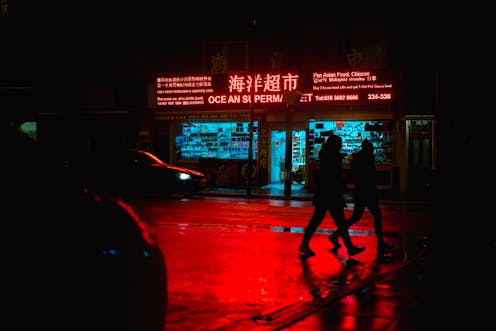Movies and TV choose to tell us different stories about the cities of today
- Written by Sebastien Darchen, Lecturer in Planning, The University of Queensland

The way cities are portrayed reveals and shapes public perceptions of the city. For young people, in particular, the media inform and disseminate the most elemental images of the city and the society that inhabits it.
The media can be an important didactic tool – often the only one available to much of the population. But, increasingly, broadcast and social media aim to entertain the public. So how do these media depictions shape how we think and feel about the city?
Most analyses of the role of media take a city-by-city approach, rather than one based on theoretical paradigms. By contrast, we analyse how three urban theory paradigms – postmodernism, sustainability and politics – translate into movies, TV series and TV ads.
Postmodernism
Feature films such as Blade Runner and its sequel, Blade Runner 2049, paint a city in which virtual reality and cyberpunks, known as replicants, have taken over humanity. The Blade Runner city is a darker and futuristic version of the LA depicted by Mike Davis.
Los Angeles, as the archetype of the postmodern city, became a lab for urban theorists in the mid-1980s. Postmodernism applied to urban theory refers to the increased privatisation and social polarisation of the city.
Blade Runner 2049 (2017), as well as the first one (1982), features dystopian city landscapes that remind us of postmodern urban theory. The movie conveys a message about society today. Virtual reality, a fragmented society and the sense of isolation felt by individuals in the contemporary city translate into the aesthetics of the movie. The movie creates a solipsistic universe – there are no social encounters of any value in the Blade Runner city.
Blade Runner 2049 and its 1982 predecessor feature dystopian urban landscapes.Movies from the “neo-noir” genre offer a dystopian vision of the city. This genre includes animation movies such as Paprika (2006), which takes place in a fantasised city considered as Tokyo. David Lynch’s movies or sci-fi thrillers such as Strange Days (1995) all feature a “neo-noir” vision of Los Angeles’ urban landscapes.
Sustainability
Movies typically show a more negative side of cities and suburban life in contrast to TV, which tends to portray a more favourable view. Feature films (Erin Brockovich, Koyaanisqatsi, Avatar) and even comedies/animations (Idiocracy, WALL-E) depict a dystopian present/future of depleted resources, corporatism and “dog-eat-dog” ruthlessness.
Unfortunately, as most films dealing with sustainability get relegated to the documentary genre (An Inconvenient Truth, Cowspiricy), only a few films get to tell this message to the masses. Good sometimes, but not always, triumphs over evil.
Alternatively, over the past several decades, many TV series (Wonder Years, Home Improvement, Will & Grace) have portrayed cities and suburbs as great places to live. They rarely engage or even mention pollution, traffic congestion, suburban sprawl or other negative aspects of suburban life.
In part this is due to the fact that most TV shows (although Netflix and Amazon productions are changing this imperative) need to attract viewers to be able to sell advertising. This means the shows rarely deal with any topic that might turn viewers away.
This positive theme carries over to TV commercials, particularly car ads, which further this favourable view of cities. Most car ads show cars in nature and on uncongested roads – they are doing this to combat the view that cars pollute and create traffic congestion. “Thelma and Louise” images of women in convertibles speeding down car-free, tree-lined roads with their hair blowing in the wind are iconic of the false representations of the city in car commercials.
Thelma and Louise draws on the iconic imagery of the freedom of the road.Politics
Again, we see split representations.
On the one hand, the city is depicted as the epicentre of glamour, excitement, opportunity and prosperity. Serials such as Sex and the City epitomise this approach.
The “sitcom city” is another version: it’s a friendly, happy place, saccharine even, with minimal conflict. In shows like Friends and Seinfeld, even New York appears to be homely and “suspiciously affordable”, as Maria Bustillos puts it.
By contrast, animated sitcoms (The Simpsons, Family Guy, American Dad!, South Park) are satirical and subversive. While centring on daily life in bland small towns, they offer stark insight into issues that other sitcoms normally sweep under the rug: religious bigotry, alcoholism, drug use, violence, weak morality, and hypocrisy.
On the other hand, the broadcast media render the city as the locus of crime, unemployment, exclusion, or injustice. Shows like The Wire embrace the realism of struggle, injustice and decay in poor urban ghettos.
Since the 1990s, a sub-genre has emerged in Eastern Europe and China to represent the post-socialist city. In European films (Good Bye Lenin!), the images of the city are grim but hopeful.
Despite grim urban imagery, Good Bye Lenin! is hopeful.In contrast, Chinese films (Suzhou River, Sunshine and Showers) depict the city as a gritty or uncanny place, thus challenging the glitzy and wholesome representations produced by state propaganda and private developers.
Authors: Sebastien Darchen, Lecturer in Planning, The University of Queensland



